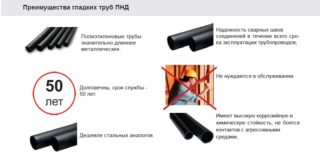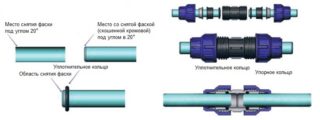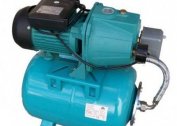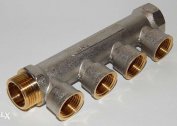Polyethylene pipes are used in the construction of drinking water and sewage pipelines. They are cheaper analogues of steel structures, but they are not inferior in strength, and in some cases even superior to metal. It is important to know how a high-quality pipe is made and how much it costs, so as not to buy counterfeit products that will not work out their proper time. Certified products have parameters that must be observed during manufacture - raw material composition, wall thickness, fluid pressure that the finished product can withstand.
Scope of water pipes PND
Low-pressure polyethylene is a durable material from which pipes with different properties are obtained with various technological nuances. The most popular are PE 80 and PE 100. Despite the fact that PE 80 is a precursor to PE 100, they are extremely different in technical characteristics. Because of this, difficulties arise in choosing, since not even all masters know how exactly these two brands differ. Many experts believe that PE 100 behaves worse in the soldering process, but this is a misconception: for a high-quality connection of two pipe sections, a higher temperature is needed. Most often, such equipment is simply not in the arsenal of the company that is engaged in laying pipelines, therefore it is advised to choose PE 80, although this type is inferior to PE 100 in all respects, except for the price.
PE 80 does not tolerate environmental influences and quickly loses its characteristics, especially plasticity under the influence of ultraviolet radiation. This means that any minor mechanical damage can lead to cracks, ruptures and failure of the pipe section.
HDPE products are used in the construction of highways for transporting drinking water. Pipes are marked with a blue line. The rest are designed for laying sewer wiring. A large number of connecting elements are made of them from the same material - bends, tees, although pipes are connected qualitatively by soldering.
Products with a small diameter are used in the arrangement of a warm floor in houses, greenhouses.
The material is resistant to corrosion and does not collect sediment inside, which makes it possible to operate it up to 50 years. The temperature range that polyethylene low pressure can withstand is from - 50 to + 55 degrees.
Advantages and disadvantages
 If we compare polyethylene pipes with steel pipes, then HDPE:
If we compare polyethylene pipes with steel pipes, then HDPE:
- practically does not need care and maintenance;
- does not oxidize and does not emit harmful substances into the liquid;
- less likely to form condensate on the surface, since the material has low thermal conductivity;
- when water freezes inside, polyethylene expands in diameter and does not tear;
- the products are light weight, so they fit without the involvement of construction equipment;
- plastic welding takes less time and is more reliable;
- fewer welds will be required, since polyethylene pipes are longer than metal pipes;
- 45% reduction in costs when replacing pipe sections;
- scale does not form on the inner surface, since the walls are very smooth and the material is chemically inert.
Of the disadvantages:
- Plastic pipes can be damaged due to soil mobility and therefore require additional protection.
- The presence of special equipment for welding.
- Ultraviolet light can damage products without a special protective coating.
- Due to temperature limitations, HDPE pipes may not be used everywhere.
The main advantage of PND is the price. Raw materials for the production of pipes are cheap, and products from it are able to compete with more expensive materials in their characteristics.
Types and specifications
 There are grades PE 63, 80, 100. PE 63 is currently used for laying electrical cables in the ground. This is an additional protection of the rubber sheath against damage. Sometimes brand 63 is used for the construction of pressure-free pipelines for cold water supply or for gas transportation. This is material that is already out of date. Many plants do not let it out because of a high predisposition to cracking. It has a short life.
There are grades PE 63, 80, 100. PE 63 is currently used for laying electrical cables in the ground. This is an additional protection of the rubber sheath against damage. Sometimes brand 63 is used for the construction of pressure-free pipelines for cold water supply or for gas transportation. This is material that is already out of date. Many plants do not let it out because of a high predisposition to cracking. It has a short life.
PE 80 and 100 are innovative materials that surpass PE 63 in all respects, therefore they are used in all areas - for the construction of pressure and non-pressure sewage systems, water pipes, gas pipelines. Manufacturers produce more PE 100 products, as their characteristics with respect to PE 80 are more advanced.
Advantages of PE 100:
- higher density, so the wall thickness may be less;
- throughput is higher due to the same internal diameter;
- less weight of the pipe with the same pressure and throughput;
- crack resistance of PE 100 is several times higher, therefore, the service life is longer;
- the material withstands very low temperatures, which makes it possible to use it in all regions of the country.
PE 80 grade pipes are cheaper, but savings can only be made if communications are constructed from small-diameter products. For example, drip irrigation systems for greenhouses or country garden water pipes located at a shallow depth. In case of damage to the pipe section, it can be quickly replaced.
Criterias of choice
Any manager in a building materials supermarket will advise you to choose the PE 100 brand. But the differences in material are not everything. The following parameters should be considered:
- For what type of trunk do you need pipes: for drinking or industrial water, sewage. Water pipes have 9 varieties. Are operated at a temperature from 0 to 40 degrees. Products for hot water are painted red.
- Estimated pressure to select the appropriate density. For storm and pressureless sewers - one view. For pressurized water supply - another.
- The number of water intake points in the house and the number of residents.
- The installation method is surface or underground. If the pipes are decided to be placed on the surface, they must be protected by a special sheath from ultraviolet radiation and mechanical damage.
- Depending on the degree of soil mobility, it is necessary to choose the strength factor of the products and additional materials for laying in the soil.
Before buying, you need to inspect the appearance of the pipes. They must be smooth and free from damage. It is advisable to buy all the parts from one manufacturer, so that the dimensions of the pipes and connecting elements fit together.
Dimensions and labeling
Each of the three grades of polyethylene has dimensions:
- outer diameter from 1 to 120 cm;
- wall width from 0.5 to 5.3 cm;
- inner diameter that determines the throughput.
The higher the pressure in the system is planned, the thicker the product walls.
The sizes of HDPE pipes for cold water supply differ depending on what diameter they have. Products with a small cross section are sold in bays. Wide cut into equal pieces up to 12 m.
For home water supply and sewage systems, polyethylene pipes with a diameter of 50 and 110 mm are usually used. External drainage depends on what kind of load falls on the sewer, taking into account the number of residents.
GOST requirements
By quality, HDPE pipes of different markings must meet the requirements of GOST:
- The inner and outer surfaces should be smooth. The presence of undulation should not deduce the diameter of the permissible norms.
- The end surfaces are smooth, without interspersed air, cracks, nicks.
- The elongation of the pipe is not more than 3% after heating.
- Resistance at constant pressure for 100 hours at a temperature of 20 degrees.
- At 80 degrees, the resistance of all grades for 165 hours at constant pressure.
- For safety reasons, the ambient temperature should not exceed 300 degrees. Material refers to flammable substances.
- Polyethylene does not emit harmful toxins into the environment. When working with it, no additional security measures are required.
- Waste after installation is harmless. They are delivered back to the manufacturer and processed.
Products are subject to preliminary testing before sending to consumers. Non-compliance with at least one item requires improvements and re-testing.
Mounting Features
Polyethylene pipes are connected in one of the ways:
- welding using the SSPT apparatus;
- fittings;
- electrodiffusion or electrofusion welding.
Some companies do not have suitable equipment for working with PE 100 because of its high cost. The device costs about 2.5 million rubles for large diameter pipes. Without it, the quality of the connections will be unreliable. Therefore, it is recommended that customers purchase a cheaper and less durable PE 80. In this case, it is better to use another technology for connecting polyethylene pipes - fittings. This will cost more by purchasing additional parts, but the whole system as a whole will be more reliable.
Laying in the soil is carried out below the freezing level. This indicator varies depending on the longitude of the location of the region. When terminating the wiring in the ground, it is not advisable to use compression fittings. The welding method in this case has an advantage - it is more reliable and durable. For flush mounting, the press fitting method is suitable. Compress the press fittings on the outer surface of the pipe with a special tool.
It is also not recommended to lay areas with joints in the ground or equip viewing wells in such places in case of need for repair. Although, there are very few cases of divergence of joints. They take place when welding is carried out by the artisanal method, without using the necessary equipment.
There should be no stones or sharp objects in the ground. They can cause premature damage to pipes and their depressurization. The best option - laying on a sand pillow.
In the northern regions, polyethylene is additionally insulated with mineral wool or other materials. This helps to increase the life of the products.
The cost of polyethylene pipes
Prices for polyethylene water pipes compares favorably with steel or cast iron. Firstly, delivery and installation will cost less, since construction equipment is not involved. It is not advisable to save on the welding machine. If you plan to independently install the system, you should consider the cost of the device for welding - for pipes of small diameter this will cost about 95 - 135 thousand rubles.
The price of the pipes themselves depends on the amount of consumables. This is affected by the outer diameter and wall thickness. Additional costs may arise if you decide to buy products with a protective coating against ultraviolet radiation. Fittings for open installation also add to the cost of the entire structure.





